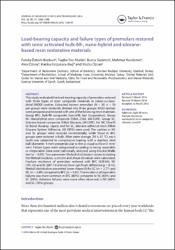| dc.contributor.author | Öztürk Bozkurt, Funda | |
| dc.contributor.author | Toz-Akalın, Tuğba | |
| dc.contributor.author | Gözetici, Burcu | |
| dc.contributor.author | Kuşdemir, Mahmut | |
| dc.contributor.author | Özsoy, Alev | |
| dc.contributor.author | Gözükara Bağ, Harika | |
| dc.contributor.author | Özcan, Mutlu | |
| dc.date.accessioned | 10.07.201910:49:13 | |
| dc.date.accessioned | 2019-07-10T19:57:14Z | |
| dc.date.available | 10.07.201910:49:13 | |
| dc.date.available | 2019-07-10T19:57:14Z | |
| dc.date.issued | 2016 | en_US |
| dc.identifier.citation | Öztürk Bozkurt, F., Toz Akalın, T., Gözetici, B., Kuşdemir, M., Özsoy, A., Gözükara Bağ, H. ... Özcan, M. (2016). Load-bearing capacity and failure types of premolars restored with sonic activated bulk-fill-, nano-hybrid and silorane-based resin restorative materials. Journal Of Adhesion Science And Technology, 30(17), 1880-1890. https://dx.doi.org/10.1080/01694243.2016.1168340 | en_US |
| dc.identifier.issn | 0169-4243 | |
| dc.identifier.issn | 1568-5616 | |
| dc.identifier.uri | https://dx.doi.org/10.1080/01694243.2016.1168340 | |
| dc.identifier.uri | https://hdl.handle.net/20.500.12511/2931 | |
| dc.description | WOS: 000374585600004 | en_US |
| dc.description.abstract | This study evaluated the load-bearing capacity of premolars restored with three types of resin composite materials in mesio-occluso-distal (MOD) cavities. Extracted human premolars (N=30, n=10 per group) were randomly divided into three groups; MOD cavities were prepared and restored with one of the following resin materials: Group BFC: Bulk-fill composite (SonicFill, Kerr Corporation), Group NC: Nanohybrid resin composite (Filtek Z550, 3M ESPE), Group SC: Silorane-based composite (Filtek Silorane, 3M ESPE). For NC Clearfil SE Bond (Kuraray, Japan) and for SC, Silorane adhesive resin (Filtek Silorane System Adhesive, 3M ESPE) were used. The cavities in NC and SC groups were restored incrementally, while those in BFC groups were restored in bulk. After water storage (24h, 37 degrees C), each tooth was subjected to compressive loading with a stainless steel ball (diameter: 4mm) perpendicular to the occlusal surface (1mm/min). Failure types were categorized according to being repairable or irrepairable. Data were statistically analysed using Kruskal-Wallis test (=0.05). Two-parameter Weibull distribution values including the Weibull modulus, scale (m) and shape (0) values were calculated. Fracture resistance of premolars restored with BFC (829.84), NC (701.35) and SC (807.73) did not show significant difference (p=0.72). Weibull distribution presented lower shape (0) for SC (m=2.77) and NC (m=3.09) compared to BFC (m=5.01). The incidence of repairable failures was more common in BFC (80%) compared to NC (60%) and SC (50%). Adhesive failures were more often observed in NC (80%) and SC (70%) groups. | en_US |
| dc.language.iso | eng | en_US |
| dc.publisher | Taylor & Francis Ltd | en_US |
| dc.rights | info:eu-repo/semantics/embargoedAccess | en_US |
| dc.subject | Adhesion | en_US |
| dc.subject | Bulk-Fill Resin | en_US |
| dc.subject | Fracture Resistance | en_US |
| dc.subject | Nanohybrid | en_US |
| dc.subject | Resin Composite | en_US |
| dc.subject | Silorane | en_US |
| dc.subject | SonicFill | en_US |
| dc.title | Load-bearing capacity and failure types of premolars restored with sonic activated bulk-fill-, nano-hybrid and silorane-based resin restorative materials | en_US |
| dc.type | article | en_US |
| dc.relation.ispartof | Journal Of Adhesion Science And Technology | en_US |
| dc.department | İstanbul Medipol Üniversitesi, Diş Hekimliği Fakültesi, Restoratif Diş Tedavisi Ana Bilim Dalı | en_US |
| dc.authorid | 0000-0001-9589-3232 | en_US |
| dc.identifier.volume | 30 | en_US |
| dc.identifier.issue | 17 | en_US |
| dc.identifier.startpage | 1880 | en_US |
| dc.identifier.endpage | 1890 | en_US |
| dc.relation.publicationcategory | Makale - Uluslararası Hakemli Dergi - Kurum Öğretim Elemanı | en_US |
| dc.identifier.doi | 10.1080/01694243.2016.1168340 | en_US |
| dc.identifier.wosquality | Q3 | en_US |
| dc.identifier.scopusquality | Q2 | en_US |


















